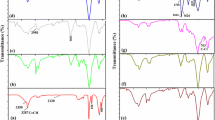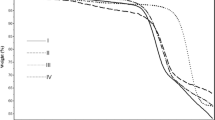Abstract
The reduction of poly(biphenylenesulfophthalide) (1), poly(fluorenylenesulfophthalide) (2), and poly(terphenylenesulfophthalide) (3) by metallic lithium in DMSO was studied using UV-visible and ESR spectroscopies. The reduction of compounds 1 and 2 affords blue diamagnetic color centers with absorption bands at 568 and 350 nm (shoulder) for 1 and at 576 and 360 nm (shoulder) for 2. The color centers were attributed to quinoid structures of the Chichibabin"s hydrocarbon type, being biradicals in the ground singlet state. The spectra of compounds 1 and 2 also exhibit weak absorption bands at ∼420 nm, which are assigned to monoradicals of the triarylmethyl type. The reduction of compound 3, for which the formation of quinoid structures is energetically unfavorable, leads to polyradicals of the triarylmethyl type with a high content (∼100%) of unpaired electrons in the main polymer chain. These radicals are characterized by absorption bands at 430 nm (allowed transition) and 638 nm (forbidden transition). The paramagnetic centers in all polymers under study give singlet lines with g = 2.0028 and ΔH ∼ 10 Oe in the ESR spectra. The color centers and radicals of the triarylmethyl type observed for the poly(arylenesulfophthalides) under study are assumed to be formed upon the dissociative electron transfer from lithium to the sulfophthalide cycles of the polymeric molecules. The PM3 calculations show a high electron affinity of the sulfophthalide cycle and a higher propensity of the fluorenyl bridge to form quinoid structures than that of the biphenyl bridge.
Similar content being viewed by others
References
M. G. Zolotukhin, Sh. S. Akhmetzyanov, A. N. Lachinov, N. M. Shishlov, S. N. Salazkin, Yu. A. Sangalov, and A. P. Kapina, Dokl. Akad. Nauk SSSR, 1990, 312, 1134 [Dokl. Chem., 1990 (Engl. Transl.)].
N. M. Shishlov, Sh. S. Akhmetzyanov, and V. N. Khrustaleva, Izv. Akad. Nauk, Ser. Khim., 1997, 389 [Russ. Chem. Bull., 1997, 46, 377 (Engl. Transl.)].
N. M. Shishlov, V. N. Khrustaleva, Sh. S. Akhmetzyanov, K. Yu. Murinov, N. L. Asfandiarov, and A. N. Lachinov, Izv. Akad. Nauk, Ser. Khim., 2000, 295 [Russ. Chem. Bull., Int. Ed., 2000, 49, 298].
S. Rajca and A. Rajca, J. Am. Chem. Soc., 1995, 117, 9172.
Z. V. Todres, Ion-radikaly v organicheskom sinteze [Radical Ions in Organic Synthesis], Khimiya, Moscow, 1986, 238 pp. (in Russian). Shishlov et al. 390 Russ.Chem.Bull., Int.Ed., Vol. 52, No. 2, February, 2003
Ions and Ion Pairs in Organic Reactions, Ed. M. Schwarz, Wiley-Interscience, New York, 1972, 1, 399 pp.
T. L. Chu and S. I. Weissman, J. Chem. Phys., 1954, 22, 21.
D. B. Chesnut and G. J. Sloan, J. Chem. Phys., 1960, 33, 637.a
J. Sinclair and D. Kivelson, J. Am. Chem. Soc., 1968, 90, 5074.
D. Braun and P. Lehman, Macromol. Chem., 1976, 177, 1387.a
A. Rajca, Chem. Rev., 1994, 94, 871.
J. A. Crayston, J. A. Devine, and J. C. Walton, Tetrahedron, 2000, 56, 7829.
N. M. Shishlov and N. L. Asfandiarov, Izv. Akad. Nauk, Ser. Khim., 2000, 1692 [Russ. Chem. Bull., Int. Ed., 2000, 49, 1676].
D. S. Boudreaux, R. R. Chance, R. L. Elsenbaumer, J. E. Frommer, J. L. Bredas, and R. Silbey, Phys. Rev., B, 1985, 31, 652.
W. C. Chen and S. A. Jenekhe, Macromol. Chem. Phys., 1998, 199, 655.
A. S. Mendkovich and V. P. Gul'tyai, Teoreticheskie osnovy khimii organicheskikh anion-radikalov [Theoretical Founda-tions of Chemistry of Organic Radical Anions], Nauka, Moscow, </del>1990, 151 pp. (in Russian).
N. A. Plate, A. D. Litmanovich, and O. V. Noa, Makromolekulyarnye reaktsii [Macromolecular Reactions], Khimiya, Moscow, 1977, 256 pp. (in Russian).
A. A. Kornyshev, A. M. Kuznetsov, J. Ulstrup, and U. Stimming, J. Phys. Chem., B, 1997, 101, 5917.
N. M. Shishlov, Sh. S. Akhmetzyanov, I. V. Novoselov, and G. I. Nikiforova, Macromol. Chem. Phys., 1997, 198, 3397.
Author information
Authors and Affiliations
Rights and permissions
About this article
Cite this article
Shishlov, N.M., Khrustaleva, V.N., Akhmetzyanov, S.S. et al. Formation of mono-, bi-, and polyradicals upon reduction of poly(arylenesulfophthalides) by metallic lithium. Russian Chemical Bulletin 52, 385–390 (2003). https://doi.org/10.1023/A:1023410900271
Issue Date:
DOI: https://doi.org/10.1023/A:1023410900271




